Truck cranes: Road to recovery
07 June 2021
High lifting capacity truck cranes are proving popular with multiple new model releases driving the market to recovery. Christian Shelton reports
In the Northern hemisphere the signs of spring are a welcome sight following a long, hard Covid-19 winter. And in the truck crane market there are positive signs, too, with multiple new product launches – particularly towards the upper end of the lifting capacity scale.
John Lukow, vice president of South Dakota, USA-headquartered trailer and heavy equipment manufacturer Load King, observed that although boom truck orders were down in 2020, “in this downturn the part of the market that has remained is the larger tonnage machines, 40 tons or more.” Load King is a division of Custom Truck One Source – which has one of the largest boom truck fleets in the USA, with more than 200 units – so Lukow is well-placed to observe this trend.
Launch exclusive: new Tadano truck cranes focus on manoeuvrability
Manufacturers are looking to satisfy this appetite for higher capacity cranes and there’s a number of new machine releases. Just this month (March 2021), for example, we exclusively report on two new HK truck cranes from Japanese crane manufacturer Tadano: the HK 4.050-1 and the HK 4.070-1, in the 50 and 70 tonne classes, respectively.
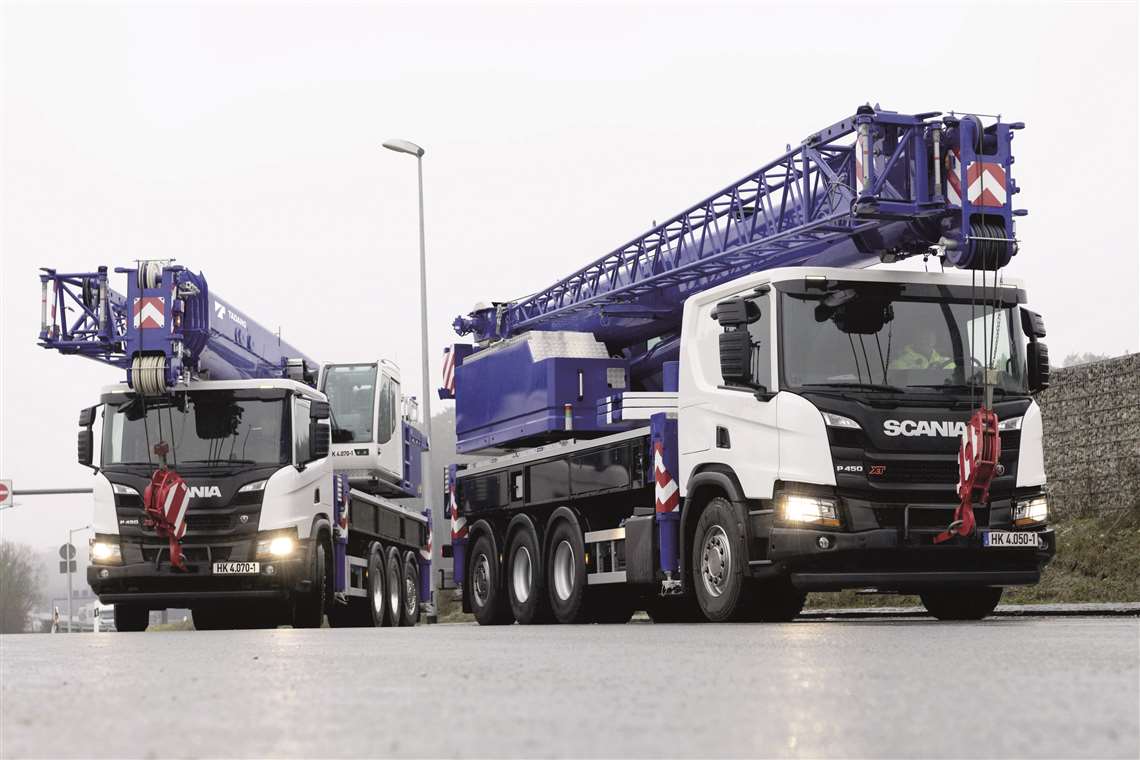 The new Tadano HK 4.070-1 (on left in both photos) and the HK 4.050-1
The new Tadano HK 4.070-1 (on left in both photos) and the HK 4.050-1
The HK 4.050-1 is 11.11 metres long and 2.55 metres wide, while the HK 4.070-1 is 11.80 metres long and 2.55 metres wide. Both cranes are less than 4 metres in height and available with Volvo and Scania chassis. The 4.050-1 can also be installed on Mercedes and MAN chassis.
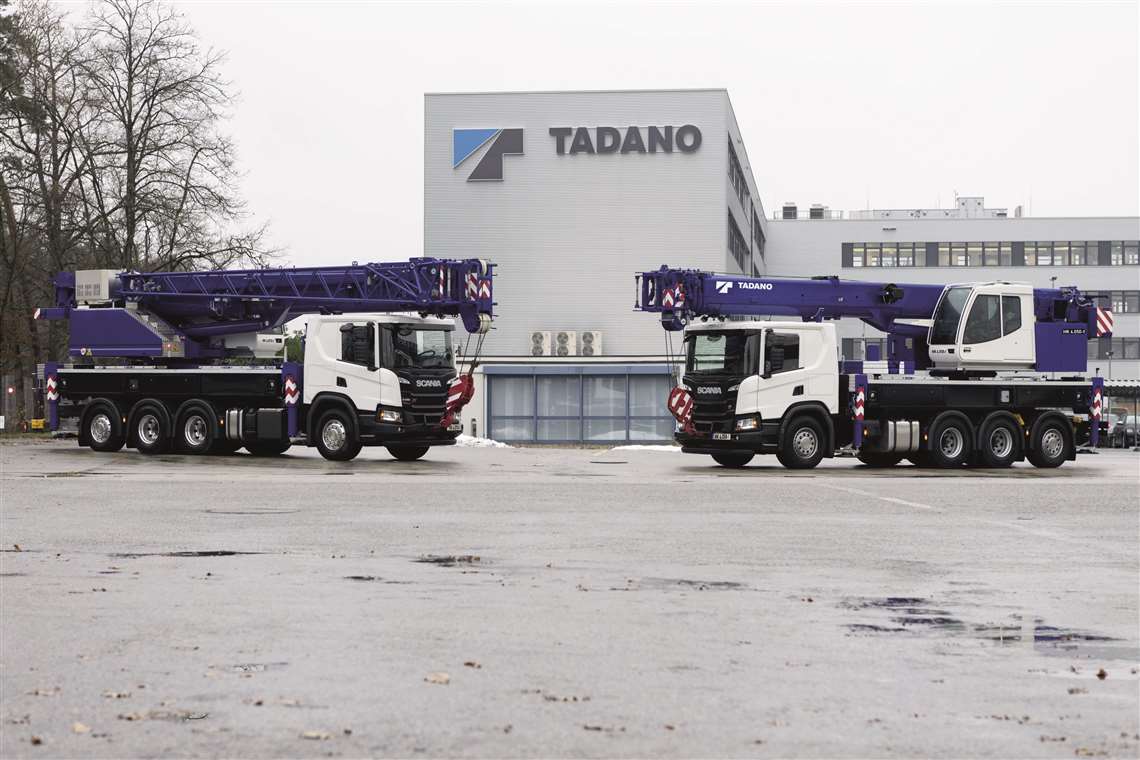
The HK 4.050-1 has a boom that can be extended to a maximum length of 35.2 metres. With the jib, this increases to 44.2 metres. The boom can lift 7.6 tonnes at a radius of 7 metres and 4.2 tonnes at a radius of 20 metres.
The HK 4.070-1 has a 41 metre main boom. With a jib, the maximum length is 56.8 metres. The HK 4.070-1 lifts up to 55.6 tonnes at a radius of 3 metres with a counterweight of 10.1 tonnes. At a radius of 8 metres, it can lift 19.2 tonnes.
Tadano says it designed the new four-axle truck mounted cranes with a focus on manoeuvrability. Both cranes have steered front and trailing axles. The second and third axles are closer to the centre of the vehicle than standard axle configurations providing a 2 metre smaller turning radius than the crane’s predecessor models.
Tadano trucks with H-style outriggers
Tadano says the two rigid mechanical axles (axles two and three) combined with air suspension for the three rear axles provide the cranes with good tractive force on the road and stability during travel.
Both truck cranes come with H-style outriggers. These are the only Tadano truck cranes to do so. Tadano says the H-style outriggers require less space compared to swing-out ones and enable the chassis to be lifted higher. The outriggers on both models can also be positioned in an asymmetrical configuration. When being used like this the crane’s AML crane control software automatically determines its maximum lifting capacity.
Emissions regulations
“We decided to develop the new series fulfilling all the latest emissions regulations, for both the chassis and the cranes,” says Michael Klein, product marketing manager, who is overseeing the cranes’ launch, “so they come with EU Stage V emission standard engines with an exhaust gas treatment system.”
The engines used in the superstructure are manufactured by Mercedes (HK 4.070-1) and Cummins (HK 4.050-1) and deliver 129 kW (175 PS) in the HK 4.070-1 and 101 kW (137 PS) in the HK 4.050-1. The superstructure and carrier engines on the HK 4.070-1 can be fuelled from the same side.
Both cranes can be set up with a 32 tonne configuration which does not require any additional road permits for many European countries. The HK 4.050-1 can carry 4.5 tonnes of counterweight while staying within axle load requirements. Even with the total 8.5 tonnes of counterweight it remains under 12 tonnes of axle load.
The HK 4.070-1 model can carry 10.1 tonnes of counterweight, although both models can be supplied with a trailer for transporting the maximum counterweight. Using the trailer means, for example, that the HK 4.070-1 can remain under a vehicle combination weight of 41.8 tonnes while carrying an additional 7.1 tonnes of counterweight on the trailer. The cranes also have a storage compartment in the body frame for tools and accessories.
Market reception for Manitowoc’s National Crane NBT60XL
In October 2020 Wisconsin, USA-headquartered crane manufacturer Manitowoc launched the 60 ton (54.4 tonne) capacity National Crane NBT60XL. “It has been very well received, especially by our dealers,” says Mike Heinrich, National Crane VP of sales. “Demand has really pushed things forward and exceeded our initial expectations.”
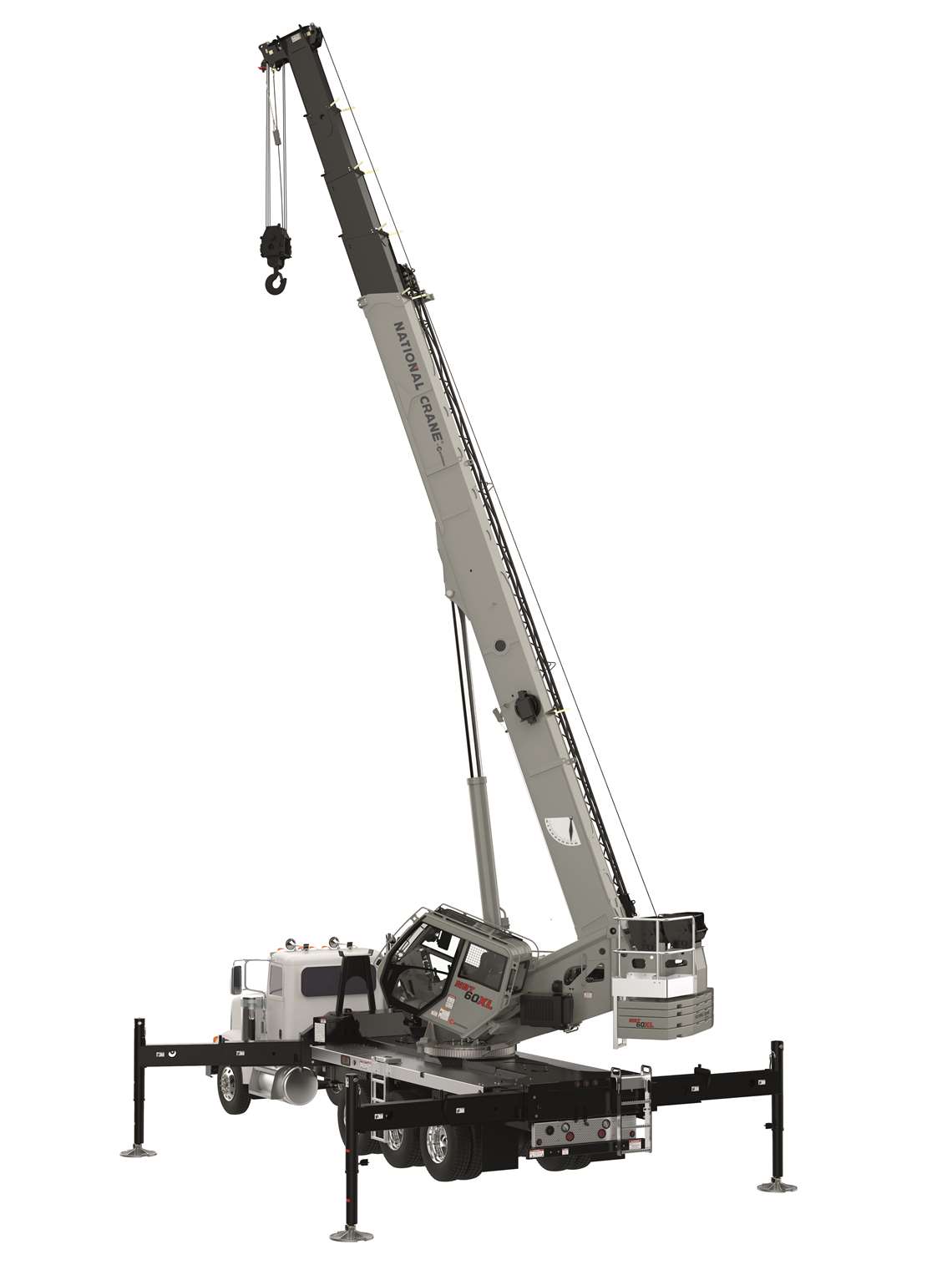 Manitowoc’s NBT40-2 series boom truck
Manitowoc’s NBT40-2 series boom truck
The new boom truck has a 151 foot (46 metre) five-section full-power boom mounted on a vehicle under 45 foot (13.7 metres) long. It can be fitted to several standard truck options, expanding layout configuration. The NBT60XL also has an hydraulically removeable counterweight configurable from zero to 16,000 lb (7.3 tonnes), allowing it to take on much heavier picks.
When equipped with the National Truck Crane (NTC) package, it has four outrigger positions, an optional two-camera system for increased jobsite visibility and a fully integrated wireless wind speed indicator. “To get even more capacity and maintain overall agility, these ‘truck crane’-style counterweights offer many combinations allowing operators to take what is needed for the job and still meet any roading regulations,” says Bob Ritter, boom truck product manager. “The NBT60XL is set to take on all competitors in the 60 ton market. Whether it be a boom truck or truck crane, this machine features the best combination of boom length and load chart capacity with a sturdy operator’s feel and plenty of comfortable manoeuvrability to get to and from any jobsite. Additionally, its commercial truck carrier adds a level of comfort, customisation and travel speed not yet available to the truck crane market.”
A 36 foot (11 metre) offsetable lattice jib can be specified. This increases the crane’s reach to 196 feet (60 metres). It also has an hydraulically tilting operator cab with heated seat and bluetooth/AM/FM stereo and speakers.
“What’s really valuable here in North America is the ability to travel with, with all of the counterweight, if needed,” adds Ritter. “Lower acquisition costs and a more comfortable ride mean there’s a lot of advantages to the to the boom truck concept.”
The NBT60XL followed hot on the heels of Manitowoc’s National Crane NBT40-2 series boom truck, which debuted in March 2020 at the ConExpo 2020 trade show in Las Vegas. The NBT40-2 series can be ordered in either a 40 or 45 ton (36.3 or 40.8 tonne) capacity, and with a 127 foot (38.7 metre) or 142 foot (43.3 metre) main boom. It has a two-piece 31 foot (9.4 metre) to 55 foot (16.8 metre) telescoping jib with a maximum tip height of 150 feet (45.7 metres), which extends to 204 feet (62.2 metres) with the jib.
Manitex International’s long boom TC65159 truck mounted crane
Remaining in the USA, Bridgeview, Illinois-based Manitex International has launched the new TC65159 truck mounted crane. It has a 65 US ton (60 tonne) base rating and a five-section 159 foot (48 metre), full power, proportionally extended boom with a 168 foot (51 metre) tip height and 206 foot (63 metre) tip height when equipped with a one-piece, 38 foot offset lattice jib.
The longer boom is designed to provide stiffness in long reach applications making it well-suited to steel erectors and other duty cycle applications where production work is key, the company said. The TC65159 will offer asymmetrical outrigger positioning, and increased ground penetration allowing the operator flexibility setting up in confined spaces and uneven terrain.
“We continue to develop higher capacity cranes that are well-suited for a wide variety of applications and offer the overall benefits of a commercial chassis,” comments Jeff Long, general manager at Manitex.
Trend towards higher crane capacity
This trend towards higher capacity in the truck mounted crane and boom crane markets has seen them encroach onto the traditional truck crane sector. “The lines are blurred,” Lukow says. “The heritage of the boom truck was that they were small, cost-effective cranes that could move rapidly down the road. But the 50 tons capacity and up is a different kind of class of cranes with different controls.” Larger capacity boom trucks need electric over hydraulics, load ratings at 10 feet, formed booms, longer booms, remote operation, operating cabs and bigger features that you get from bigger cranes, he said.
News of another new truck crane, however, perhaps offers a glimpse of an alternative future for the truck crane sector. Although it may only have a capacity of 25 tonnes, the ZTC250N-EV (first reported in ICST May 2020) from Chinese crane manufacturer Zoomlion is a fully battery-electric truck crane that comes packed with cutting edge technology.
The manufacturer claims it can be 80 percent charged from flat in just one hour and that the crane functions can be used while charging, assuming availability of sufficient site power. The crane’s superstructure batteries double as counterweight.
Automation features heavily – offering control of the outriggers, crane setup, plus lifting and rotation in accordance with preset lifting plans. Automation even extends to driverless movement of the carrier along a predefined route. Lifting plans can be imported from a cloud and a 3D generation of lift plans can be viewed.
A laser-scanning system is promoted for obstacle avoidance, while an object recognition function allows it to lock and track target objects being hoisted. Real time monitoring is provided by onboard cameras and the crane has anti-sway control.
 Zoomlion’s new 25 tonne capacity battery-electric ZTC250N-EV is loaded with tech
Zoomlion’s new 25 tonne capacity battery-electric ZTC250N-EV is loaded with tech
Zoomlion says that, fully charged, the carrier has a range of 230 km and on-the-road electricity consumption is 150 kWh per 100 km. The crane has up to 1,500 Nm of torque which Zoomlion says means it can tackle slopes of 50 percent gradient.
Data reports and associated apps complete the crane’s features on first sight of this tech-laden truck crane.
It will be interesting to revisit this sector in 12 months to see how popular this tech-heavy crane has been and if any other truck crane manufacturers follow in a similar direction.
 The AK 52 has an extension length of 52 metres and a reach of 45 metres
The AK 52 has an extension length of 52 metres and a reach of 45 metres
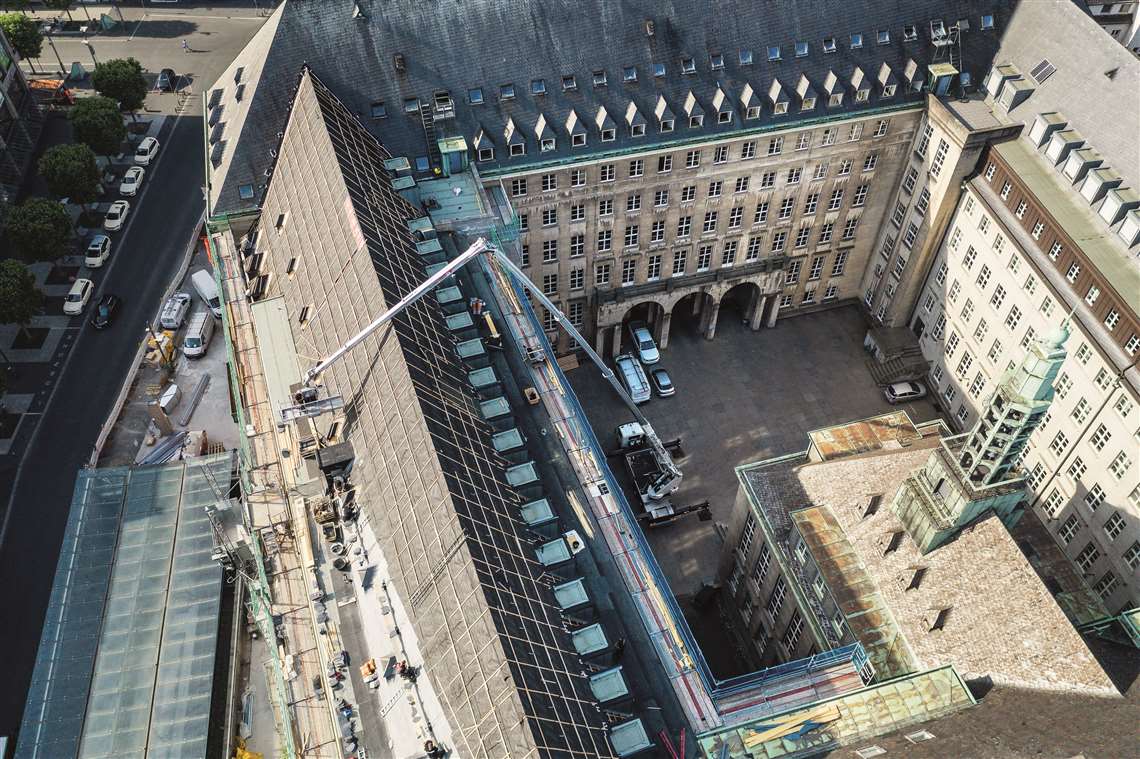
The AK 52 has a maximum capacity of 12 tonnes, an extension length of 52 metres (this can be increased to 55 metres) and a reach of up to 45 metres. It can lift three tonnes to a height of 31 metres with a reach of 17 metres. The telescopic mast system is made of a combination of steel and aluminium alloys and offers 360 degree pivoting. Its 14 metre jib is fully hydraulically driven via remote colour control and holds up to one tonne even in a total extended horizontal position.
The AK 52 lifted the materials from the building’s inner courtyard. The AK 52 is well-suited for use in use in tight spaces, says Böcker. Even when the maximum reach is attained, the slewing radius is only 2.2 metres, and the turret protrudes no more than 0.9 metres beyond the frame of the carrier vehicle, as the crane does not require any extendable counterweights, it illustrates. Variable outrigger positions and high ground clearance are designed to facilitate on-site set-up. Sensors on each support are designed to ensure that the load on the ground is distributed optimally and that the axles retract automatically during levelling. The AK 52 has rear-axle steering designed for manoeuvrability and drivability.
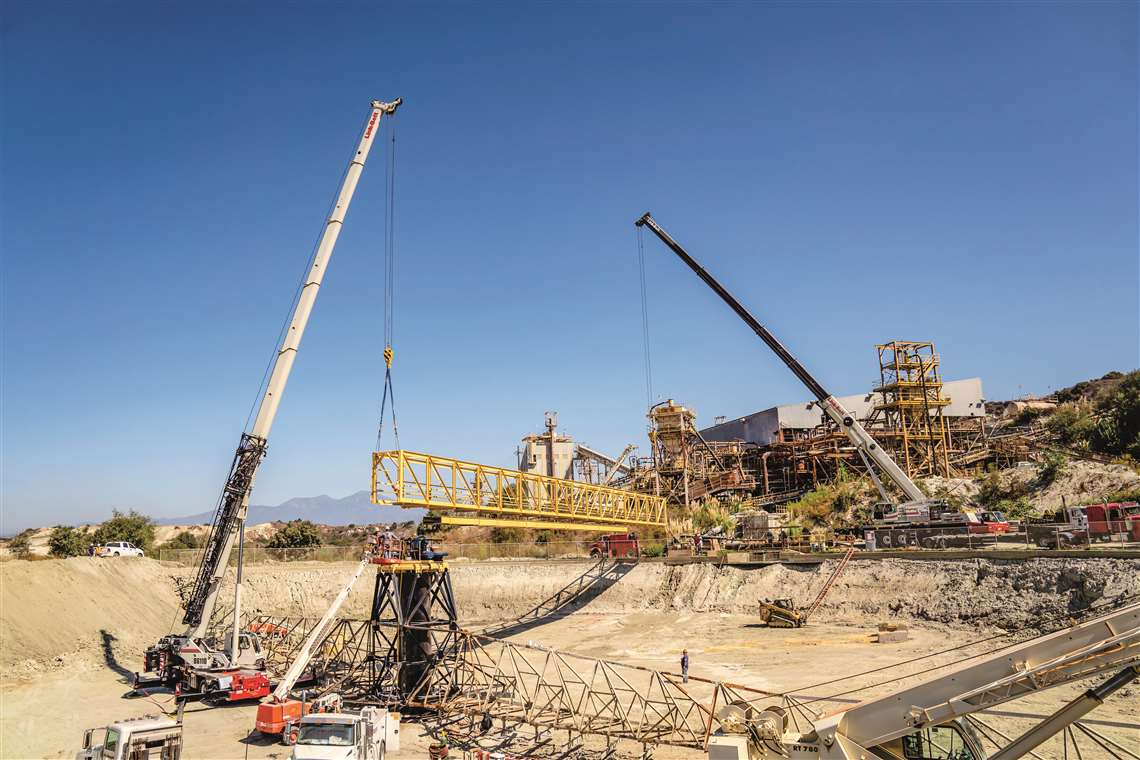 Anglemyer’s Link-Belt HTC-86110 (on the left)
Anglemyer’s Link-Belt HTC-86110 (on the left)
“It was a unique setup,” said crane operator, Mike Norris, who ran the HTC-86110. “A temporary ramp was built for us to get the HTC-86110 down into the pond. Then we were set up along with the ATC-3275 so we could pick the bridge and set it into place.”
Reach for both cranes was important for positioning the bridge. “The ATC-3275 had to pick about 15 feet [4.5 metres] further than the HTC-86110, so we had it on higher ground on the bank,” said Norris.
The HTC-86110 was equipped with full counterweight – 48,600 lb (22 tonnes) – to handle its end of the bridge. “On our end, we had close to 36,000 lb [16 tonnes] lifted and placed on the centre rotating joint,” said Norris.
“The HTC-86110 is new to us and as soon as it got to our yard, it went straight to work” Norris added. “We’ve put a little over 700 hours on it and 9,200 miles [15,000 km] on it since we received it in April (2020). The HTC-86110 keeps a tight footprint – a little bigger than our 40 tons – and more manoeuvrable than anything in the 200 ton class that we have.”
CONNECT WITH THE TEAM




